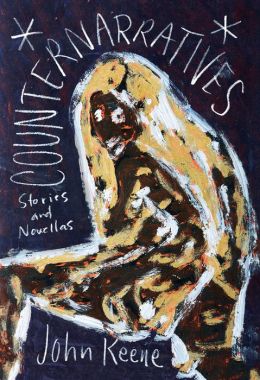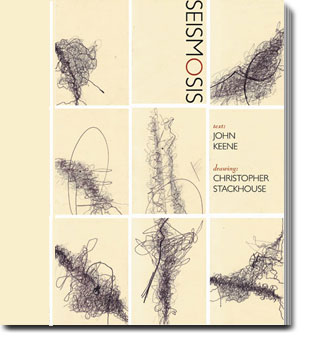
There's something to be said for CP time, especially when you're trying to park in a city where finding spots on the street in certain neighborhoods after 5 pm is notoriously difficult, verging on impossible, and you have to circle the block about 15 times, burning expensive ($2.85 regular unleaded) gas all the while, until someone finally pulls out and you can quickly slot your car in, leap out and sprint into the
Silver Room, on Milwaukee in the Wicker Park neighborhood of Chicago, hoping you haven't missed the poets you'd wanted to see.
Of course, slow as things are in getting started, you do end up missing one (the lovely wordsmith and collagiste
Krista Franklin), but you arrive in time to catch
Charlie Dark (blurry cellie photo above), one of the British poets (and DJs) who's featuring tonight as part of
Malika's Kitchen 2nd Annual Poetry Gathering, which brings together American (mostly Chicagoan) and British poets (mostly Londoners), including a raft of young Black and Asian British wordspitters, who're visiting fellow young poets in the Chicago area, exchanging words and thoughts and possibilities, and you're actually dazzled to see the future unfolding before your eyes. These young poets serve up poems so beautiful and honest you almost want to weep as you clap. One young brotha pops in the front and back of the Silver Room. A young woman writes about her "scarf," which she is embracing and defending. Another young man's poems shift between English and an South Asian tongue you cannot understand, but his final image, of wanting to substitute his own face for his mother's when his father's fists come, translates across all languages. Four young poets--all Britons, one the child of Afghans, the other of Bangladeshis, the third of Somalis, and the fourth who just describes himself as "Black," recite a group poem that brings the house down.
Ugochi Nwagwugwu, the MC, keeps the poetry and good spirits flowing.

And you realize that you haven't missed the other poet you came to see, the incomparable Ms.
Toni Asante Lightfoot (at right), who breaks off a sexy haiku called "Lollypop Blues"
Kalamu Ya Salaam-style (which is to say 17-syllables become a call-and-response performance), and reads one of her stirring "Moms Mabley" poems, "Losing Loretta Aiken," which appears in the
Malika's Kitchen Handmade Fire chapbook that she designed and co-introduced, with Chicago chapter founder
Peter Kahn. The poem is so stirring that afterwards, as you're standing outside in the rising cold, chatting with Toni, a handsome young man comes out and says to her, "That was some adult poetry. Mad! Mad! Mad good!....Def!" and you'd have to agree (if in different words). You also remember the sharp poems of one of the Malika's Kitchen Chicago members,
Kevin Coval, whose point of departure is Elvis (what is this fixation with Elvis, you always ask and groan), though Coval actually takes it somewhere you hadn't expected, and Malika's Kitchen British co-founder
Jacob Sam-LaRose, who favors someone you've actually seen many times, or maybe people you grew up with, but whose powerful poetry is utterly his own. The many of the poets and audience members start filing out, to chat and exchange numbers and just congregate, as Charles Dark spins inside, and you meet a few people--a singer named Maritza, one of Toni's former students who's writing myths, and you take your leave, wish the young Brits a safe trip home and hop in your car and zoom back north, your head still full of lines like "the bowstring of the wind / makes the Chicago leaves sing," and the future of humankind looks and feels a little brighter....
***
I learned on Tuesday (or Wednesday) that I get Logo (which does NOT show up on
TV Guide Online's RCN Chicago lineup, oddly enough), so I got to see the most recent episode of
Noah's Arc, as well as the prior one (which I thought was so bad I ended up watching Martha Stewart's Apprentice instead). I'll leave the play-by-plays and appraisals to the matchless
Rod 2.0 (he hasn't posted on this one yet), but I did think this was the best written and acted episode by far. By far!
Noah-Doris still parades around like a slightly buffer
Tracy Ross in costumes and hairstyles that never cease to amaze me, and
Ricky-Halle Minnelli remains TV's wildest mess since H. R. Puffinstuff, but the
Chance character was hilarious as a thug-in-training (he's actually kind of cute in a do-rag),
Wade's quasi-hetero/bi character lights up the screen with his smirks and cornrows, and
Alex continues to shine in his role as the HIV-counselor/drag diva/mama bear/wit machine. He even demonstrated an on-the-spot HIV test in his storyline, which I think is the first time I've seen that on any program, ever! I continue to enjoy watching the show, criticisms aside, in part because, as I realized, there's no show on TV that has featured this many and wide a range of Black gay/sgl men onscreen in just a four week span. (And they even included an identifiable Latino and several White people as well, it being Los Angeles/West Hollywood, and all.) So what if they toss out "bitches" and "girls" like candywrappers--well, okay, but let's have that misogynistic conversation another time. I say keep it going, chirrens! Aim for the stars, or at least the disco balls!

I also caught broadcast of
Oprah Winfrey's interview with author
Terry McMillan and her ex-husband,
Jonathan Plummer, who served as the prototype for the young island lover in McMillan's blockbuster novel,
How Stella Got Her Groove Back. Again, I'll leave it to the
incomparable Rod 2.0 to fill you on in the details (the photo of Jonathan Plummer at right comes from his site), but I did think that the Divine Ms. O seemed not only to be questioning Jonathan (who is so sweet he'd make a canefield jealous) a bit hard, but taking it a bit...personally. In fact, she even said that his lawsuit against his multimillionaire, middle-aged ex-wife for some of her money, made Ms. O. "not like" him. The lawsuit (yes, there'd been a prenup), not the coming out--at 26 or 27--as gay, that is, though she pressed that point hard as well, because you know, we all do realize we're gay from the age of 4, or "6" or "9" or whatever. (Anyways, Stedman, you've been forewarned.) Ms. O didn't prosecute Terry McMillan that much (even though McMillan supposedly found gay leather porn
in loverman's car trunk back in 1995, and from all the past photos and video of him they showed, he'd hardly be out of place as one of the girlfriends on, well,
Noah's Arc!), but then again, as she noted at the end of the show, she'd bought the option to McMillan's new book, and the film version was now in "pre-production," so the whole show was a major promo for the new book (anyone who's been alive the last ten years knows what an Oprah endorsement does for book sales!) and will probably earn McMillan many times the amount she had to shell out as part of the October 4th divorce settlement (Plummer got very little).
I do have to say that McMillan, whom I've met and admire (despite the "Jonathan's fag boyfriend fag" note and so on), really does love to make those dramatic "crack" faces and sighs. Also, she at 54 and the ageless Ms. O both look quite good, so I guess the good genes + millions (or billions in Ms. O's case) in the bank combo is what it's cracked up to be, and so why wouldn't Jonathan, who's got the genes part, not want to get in on the other part as well? Charming best describes the now out, hairstyling- entrepreneur Mr. Plummer, whose lips and eyes (as well as some things
(rudeness) weren't on display) surely sent McMillan's heart and pumpum spinning (and at times it looked like she was back there for a split second). She did share with all of us that he took her beyond orgasms, that he was young enough to learn some tricks, that like a puppy, you know, she'd taught him how to lick well (uh huh), and other salty (or saucy, whichever you like) tidbits from their marriage. But then McMillan's all about the realness, you know. Did I mention she has a new book out, that Ms. O's optioned? Hey, what's this strange signal I'm picking up? O(H)--MUST GO BUY, MUST GO BUY, MUST GO....
 Yesterday, Oglala Sioux author, scholar and activist Vine Deloria Jr., one of the major figures in the Native American rights and resistance movement, passed away yesterday. I'm posting comments forwarded to me (via Tyehimba Jess--thanks Jess!) by NYU Hemispheric Institute curator Rachel Chapa:
Yesterday, Oglala Sioux author, scholar and activist Vine Deloria Jr., one of the major figures in the Native American rights and resistance movement, passed away yesterday. I'm posting comments forwarded to me (via Tyehimba Jess--thanks Jess!) by NYU Hemispheric Institute curator Rachel Chapa:



 I close my eyes and see a flock of birds. The vision lasts a second, or perhaps less; I am not sure how many birds I saw. Was the number of birds definite or indefinite? The problem involves the existence of God. If God exists, the number is definite, because God knows how many birds I saw. If God does not exist, the number is indefinite, because no one can have counted. In this case I saw fewer than ten birds (let us say) and more than one, but did not see nine, eight, seven, six, five, four, three, or two birds. I saw a number between ten and one, which was not nine, eight, seven, six, five, etc. That integer--not-nine, not-eight, not-seven, not-six, not-five, etc.--is inconceivable.
I close my eyes and see a flock of birds. The vision lasts a second, or perhaps less; I am not sure how many birds I saw. Was the number of birds definite or indefinite? The problem involves the existence of God. If God exists, the number is definite, because God knows how many birds I saw. If God does not exist, the number is indefinite, because no one can have counted. In this case I saw fewer than ten birds (let us say) and more than one, but did not see nine, eight, seven, six, five, four, three, or two birds. I saw a number between ten and one, which was not nine, eight, seven, six, five, etc. That integer--not-nine, not-eight, not-seven, not-six, not-five, etc.--is inconceivable.  There's something to be said for CP time, especially when you're trying to park in a city where finding spots on the street in certain neighborhoods after 5 pm is notoriously difficult, verging on impossible, and you have to circle the block about 15 times, burning expensive ($2.85 regular unleaded) gas all the while, until someone finally pulls out and you can quickly slot your car in, leap out and sprint into the
There's something to be said for CP time, especially when you're trying to park in a city where finding spots on the street in certain neighborhoods after 5 pm is notoriously difficult, verging on impossible, and you have to circle the block about 15 times, burning expensive ($2.85 regular unleaded) gas all the while, until someone finally pulls out and you can quickly slot your car in, leap out and sprint into the  And you realize that you haven't missed the other poet you came to see, the incomparable Ms.
And you realize that you haven't missed the other poet you came to see, the incomparable Ms.  I also caught broadcast of
I also caught broadcast of 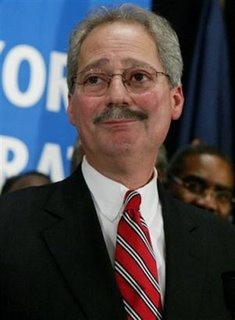
 Many thanks to
Many thanks to 

 I've only been able to make my way piecemeal through
I've only been able to make my way piecemeal through 

 This evening while waiting in Walgreens for the pharmacist to process my order, I flipped through
This evening while waiting in Walgreens for the pharmacist to process my order, I flipped through  They are (and I'm recounting this from memory)
They are (and I'm recounting this from memory)  Today I voted by absentee ballot in the
Today I voted by absentee ballot in the  I've never seen any of
I've never seen any of  who for his chicanery got to sit behind Laura Bush at W's
who for his chicanery got to sit behind Laura Bush at W's  Ahmadinejad said that Iraq needs to strive for expansion of ties with its neighbors as a way to thwart the plots for stoking religious and sectarian rows.
Ahmadinejad said that Iraq needs to strive for expansion of ties with its neighbors as a way to thwart the plots for stoking religious and sectarian rows.




 Economically, politically and socially marginalized. Denied opportunities in higher education and decent-paying jobs because of their color, their names, their backgrounds. Housed in grim, high-rise ghettos cut off from the centers of society. Openly treated as second-class citizens and discriminated against by "mainstream politicians" and agents of the police and penal systems. Lacking almost no representatives in the national political structure, and rarely seeing themselves represented in the media, except in the popular culture they fashion for themselves. No, I'm not talking about the United States this time, but about France, where riots in the impoverished ghettos ringing its capital city, Paris, have raged for nine days, and have now spread to other parts of the country.
Economically, politically and socially marginalized. Denied opportunities in higher education and decent-paying jobs because of their color, their names, their backgrounds. Housed in grim, high-rise ghettos cut off from the centers of society. Openly treated as second-class citizens and discriminated against by "mainstream politicians" and agents of the police and penal systems. Lacking almost no representatives in the national political structure, and rarely seeing themselves represented in the media, except in the popular culture they fashion for themselves. No, I'm not talking about the United States this time, but about France, where riots in the impoverished ghettos ringing its capital city, Paris, have raged for nine days, and have now spread to other parts of the country.


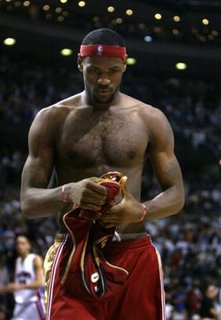 I have nothing against the very attractive young man at left,
I have nothing against the very attractive young man at left,  When airline pilots or steelworkers or nurses or high school teachers other people who don't get paid 10x-100x+ the average salary of most Americans go on strike for better wages or continued health care coverage or pension protection, I'm with them. But these overgrown whiners get none of my sympathy, nor do their bosses, very rich men all of them, who've helped to drive away fans by their pettiness, greed and self-absorption, while also encouraging bad, violent play and endlessly peddling their crapola branded merchandise, which is probably produced at slave wages, to children and adults who can least afford it every day, dumping most of the money back into their own pockets. So I say impose your new dress code, or don't. I don't care. Fill the league with nothing but European and Latin American and Chinese players, I don't care. Line the floor with giant troughs that deranged fans can slurp beer out of before they insult the players like the overpaid, overhyped entertainers they are, and then have the players turn around and whale the living daylights out of them in fights that would make the stars of Ultimate Fighters jealous, I don't care. Never again, nunca, jamais, niemals, thank you very much!
When airline pilots or steelworkers or nurses or high school teachers other people who don't get paid 10x-100x+ the average salary of most Americans go on strike for better wages or continued health care coverage or pension protection, I'm with them. But these overgrown whiners get none of my sympathy, nor do their bosses, very rich men all of them, who've helped to drive away fans by their pettiness, greed and self-absorption, while also encouraging bad, violent play and endlessly peddling their crapola branded merchandise, which is probably produced at slave wages, to children and adults who can least afford it every day, dumping most of the money back into their own pockets. So I say impose your new dress code, or don't. I don't care. Fill the league with nothing but European and Latin American and Chinese players, I don't care. Line the floor with giant troughs that deranged fans can slurp beer out of before they insult the players like the overpaid, overhyped entertainers they are, and then have the players turn around and whale the living daylights out of them in fights that would make the stars of Ultimate Fighters jealous, I don't care. Never again, nunca, jamais, niemals, thank you very much! Friend, artist and poet
Friend, artist and poet 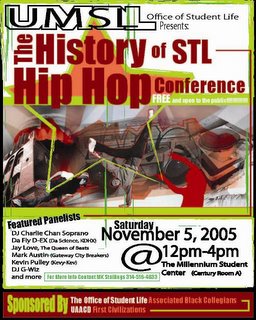 From the
From the 

